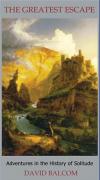Balcom, David. The Greatest Escape: Adventures in the History of Solitude. Lincoln, NE: iUniverse, 2004.
 A
universal history of hermits and solitaries is too daunting. In recent years,
for example, Peter France confined himself to a handful of biographical
sketches, and Isabel Colegate offered a hodge-podge of anecdotes and trivia.
David Balcom has taken a different approach, presenting instead a history of
solitude. He emerges from the plunge with a congenial survey of highlights and
insights, presented in personable, often first-person narratives Balcom likens to "adventures."
A
universal history of hermits and solitaries is too daunting. In recent years,
for example, Peter France confined himself to a handful of biographical
sketches, and Isabel Colegate offered a hodge-podge of anecdotes and trivia.
David Balcom has taken a different approach, presenting instead a history of
solitude. He emerges from the plunge with a congenial survey of highlights and
insights, presented in personable, often first-person narratives Balcom likens to "adventures."
The author uses a device he dubs "Friends of Solitude," a collective concept that gathers kindred souls who have "left records of those experiences [of solitude] either in their own writing or in the writings of others about them." It is a phrase borrowed from Nietzsche, who confessed his kinship with "born, sworn, jealous friends of solitude." The great German thinker imagined these friends to be all philosophers alienated from society, who like Zarathustra, "enjoyed and quaffed solitude," who seek nothing but to "live peacefully and cheerfully, even amidst the turmoil."
But Balcom's organizational model is the Italian Renaissance poet and essayist Petrarch, a cultivated figure of refined interests for whom solitude was both religious and secular, epicurean and ascetic, a pragmatic tool of psychological refreshment and -- to borrow the book's title -- the "greatest escape." Petrarch's Life of Solitude is half history, half personal reflection, and Balcom's book shares this structure.
Petrarch resurfaces at the head of most sections of the book. His push and pull with solitude, his creative needs, romantic angst, his appreciation of nature, balance, and social conviviality, are a good check on the progress of solitude's history. "I want a solitude not utter," he wrote, "a leisure not inert and useless, but a retreat which may be profitable to many." And Balcom fashions his book to complement that retreat.
The book unfolds chronologically, beginning with shamanism, Indic mythology, and the great figures of ancient Greece and Rome. The approach here is not to find eremitic precursors but rather the discovery of solitude in the development of wisdom insights. The primary chapters include poetry and Taoist quotes for "Ancient China," a support of Arsenius and Evagrius on the "Desert Fathers," uses of solitude among Sufis. "Medieval Europe" focuses more on literary and mystical themes as in Ruysbroeck and The Cloud of Unknowing. We return to China and Japan for brief portraits of Bodhidharma, Han Shan, Stonehouse, and Basho. Under "Modern Recluses," the author cites Burton (of Anatomy of Melancholy fame), Wordsworth, Dickinson, Valery, Proust, Robinson Jeffers, and Thomas Merton as "friends of solitude."
Polemics are covered in "Reply to Cloisterphobia" with attacks on asceticism by Luther, Hume, and Gibbon. Francis Bacon defended the primacy of "community" against solitude, and novelists such as Melville, George Eliot, and Conrad have depicted solitaries as insane. Countering them are Toynbee and Joseph Campbell, who have perceived the universal motif of withdrawal and return, plus poet Rilke and monk Merton, who have defended the psychology of solitude and the struggle to overcome alienation.
Developing the theme of psychology and solitude, Balcom then explores Patanjali and Nagasena. He offers a continuum of fruits of solitude, from creativity to joy to enlightenment, here relying on diverse sources such as William James, Anthony Storr, and Abraham Maslow.
Perhaps Balcom is a little harsh with social reformers and social scientists, including them as "hermit bashers." In the conceptualization of alienation, sociology has offered analytical tools that have become more relevant with the rapid evolution of technology and mass culture. The emergence of existentialism and social critiques has complemented the evolution of spiritual thought in the last century, with the uses of solitude an important component. Readers may find the depiction of Ronald Reagan as "one of the key people behind" recent society's more tolerant attitude towards solitude to be problematic.
The author concludes the narrative section with an exploration of the theme of the "knight of faith," ranging from the conversation of Krishna and Arjuna in the Bhagavad Gita to themes in Meister Eckhart and Kierkegaard.
The book is completed with generous bibliographical references reflecting the author's wide interests and reading. The titles comprise a context for understanding solitude in history, theory, and practice, a kind of "great books" list for the appreciation of the book's subject.
The Greatest Escape works well as a survey of "friends of solitude," in identifying threads of commonality between disparate figures, times, and places in history. The kinship is wide and tolerant, and the book is a leisurely conversation sharing the minds and hearts of many we can truly call our own friends.
¶